A number of you have asked recently how it is that I pack for work trips when it comes to working (or other sports). I don’t remember the last time I took a trip and didn’t work out. It’s just sorta part of the package. Heck, even on some day trips I’ll manage to sneak in an occasional run. I also think it can be easy to find excuses to not work out while travelling. So I’ll cover some tips as well at the end. First up, making it fit.
And for those who may be new around here – I kinda travel a fair bit for work. This year I’ll easily clear between 250,000 and 300,000 miles. No, that wasn’t a typo. I travel almost every week, from quick 75 minute train rides to 22 hour flights. Every week is a new country and usually a new continent.
My Suitcase System:
I have three suitcases. Two of which get regular use. At the smallest end I have an 18” roll aboard suitcase that I use for most trips under about 5 days. Then I have a 22” roll aboard suitcase that I use for trips between 5 days and two weeks. And finally, I’ve got a big gigantic suitcase that I’ll use beyond two weeks (i.e. a cruise/long vacation/etc…) – typically when I’m taking a lot of clothes/items. I use that probably once per year. In the below case, it’s my 22” roll aboard:
(The above photo was on the last day of a two-week trip through Australia and New Zealand. Some clothes are in a plastic bag because they were clean from laundry service.)
Almost everything of mine workout-wise fits into a single cloth bag. This is the bag that’s normally given at out triathlons these days, but has long been used by swimmers and others. I put my running shoes inside of this. The reason for this is that if it’s muddy/wet/stinky/whatever, it keeps it inside. While I could use a plastic bag (and sometimes do inside the cloth bag if things get really ugly) – eventually that tears.
Next to the shoes I usually throw my heart rate strap (though my regular running watch I tend to keep in my backpack). Additionally, I have a spare phone arm-band for running with it – in case I get lost or something. Also useful for holding a bit of cash or room key.
Inside this cloth bag I’ll then stash my swimming stuff. Everything fits into a swim cap. Goggles, swimsuit, swim watch, and swim cap. Done.
Now I do often keep a spare swimcap, pair of goggles and suit in the front pocket of my suitcase. I do this because sometimes the one in my clothes bag will get caught up in the unloading process at home and not make it back in.
When it comes to workout clothes, I try and carry only 1-2 pairs of shorts/t-shirts/socks. All I do is post workout while in the hotel shower I simply wash them quickly with soap/shampoo and then rinse. After that’s done, I just hang them up. Many hotels have clothes lines over the bathtub (Note: In Europe sometimes those aren’t actually clothes lines but ‘help lines’ – so poke around a bit).
However, for hotels that don’t have that, the trick is finding the air vent in the room, and then wedging a hanger from the closet up there. Almost all hotel rooms have the air vent about 4-8 feet after entering the room. With even just a tiny bit of airflow, your clothes will quickly dry by morning – even with abnormally small vents like these:
(The above photo was taken in Wellington, around 10PM, the clothes were dry by time I left for the airport around 4AM.)
Dirty or wet clothes go into the bag with the shoes. Generally inside a plastic bag inside that bag (just grab a plastic laundry bag from your hotel room’s closet). In the event your hotel is more swanky and the laundry bags are fabric, grab a plastic bag from your ice machine bucket. This keeps it from stinking up the rest of the suitcase.
Lastly, I always have a spare CR2032 battery in there, since I find it useful in most heart rate straps or sensors. And if I know I’m going for a ride, I’ll toss in a quick release ANT+ speed/cadence sensor too. I use a rare-earth magnet with it and just stick it on the back of the pedal spindle, so I don’t have to have any tools.
Working while travelling tips/thoughts:
I’ve written about this a bunch before, so here’s some new thoughts about four years later – and a lot of miles later.
Fighting excuses:
Trust me, I’ve heard them all. And, on occasion, taken part in them. I am not immune to that. For me I attempt to balance getting workouts in on a regular basis, with making it through the end of the week in one piece.
Schedule the week: A lot of it comes down to having a schedule for the week before the week even begins. I work carefully with my coach to outline my schedule as best as possible, and then he puts together a workout plan that takes everything into account. Over the years he’s come to understand what works best for me, and what doesn’t. For example:
1) Mornings before flights: If from home, a trainer ride or run works best. This removes any pool logistics issues. If on the road, a run works best. This removes any gym issues.
2) Upon landing: If the flight is more than about 5-6 hours, then it’ll likely be something in the 40-minute range. Typically either a 40-minute run, or a 30-40m easy trainer ride. If it’s less than that, HTFU and get a workout done (unless the schedule is wonky that day).
3) Harder efforts: This past week while travelling I had two ‘hard’ interval workouts. One was a 90ish minute brick (short hard bike, long interval run), and the other was a 2hr brick (long hard bike, short-hard run). He separated these out, and put them away from the travel days, so that I could recover a bit before diving into them.
4) Swims: Swimming while travelling is the bane of my existence. Sometimes it works out great, and then other times it’s a flotilla of fail boats. Pool schedules, bad/crowded facilities, etc… That said, I do try. But I mentally and physically prioritize swims while travelling lower. Especially if I’m lying in bed at 5AM trying to fit in 2 hours worth of logistics and workout time.
Schedule the the day: In addition to having a weekly schedule, spend 30 seconds the night before putting together the next day’s schedule, inclusive of the workout. For example, I’m sitting on an 11 hour flight back home right now, but here’s my schedule this morning inclusive of my 90 minute run (simply done in notepad):
6:30AM Wakeup
6:45AM Leave for run
8:15AM Back/Shower
8:30AM In car driving/gas at airport
9:45AM Rental car facility
10:00AM Airport door
11:23AM Flight
I worked backwards from my flight time to when I woke up. In case you’re curious – the massive gap in the car was to account for rush hour traffic (I ended up at the airport door 6 minutes early per my schedule).
Just get it done: With the schedule done, it removes any ambiguity. In my mind, there’s generally only one choice: Get it done. I can plan out exactly when in the week I’m going to complete the workout based on what work commitments I have. Meaning, if I know that I’ve got meetings from 8AM till 5PM, and then know that people want to hang around and chat till 5:30-6PM, and then suspect that a co-worker/team will want to do dinner at 7PM – I’ll do my workout first thing in the morning. Even though I’m not an early bird. At. All.
Take Advantage of Time Zones: It’s funny, if done right you can really work the time zone system to your advantage – even when skipping forward (going East, going West is simple). Take for example this past November when The Girl and I flew into Dubai. We landed a little before midnight, but both of us were wide awake. Rather than head out into the hot sun some 6-8 hours later in the early morning, we just simply headed out and did a run at midnight.
The same thing goes for severe jetlag, which may have you waking up at 4AM. Like my time in South Korea – where I was standing at my hotel window waiting for the sun to rise to start running. Had I tried to run at 6PM, I’d been shot. Again, not a morning person – just getting it done versus watching CNN.
Taking workout clothes takes too much space: No, you don’t get to use this excuse. Sorry, it’s been revoked. I’m 6’2”, everything I have is big. From my big flopping running shoes to my clothes. It takes up almost half my suitcase. Yet I still make it work (and yes, I often do bring suits/coats with me). Minimalize other things. Minimalize your workout clothes to just a pair of shorts and t-shirt and shoes. When I cycle in the gym, I just use running shorts. It’s one less thing to bring.
The logistics of workouts:
I’d be lying if I said I didn’t sometimes find the logistics the most daunting thing. Because finding a route in a new city can be tough – especially for long runs and the like. But, in today’s technology driven age, there’s really no reason for excuses here any more.
Running: For running, start by simply ask your hotel folks where a local running or cycling trail is. Next (since they won’t likely know), go to Garmin Connect or MapMyRun. You don’t need an account (and if you want one, they’re free).
If in the US, use the Garmin Connect heat maps to figure out where people are running. Here’s a look at Seattle. Not to point out the obvious, but that red circle is where people run. A lot. Go there.
Outside the US (no heat maps yet), you can still use Garmin Connect to find running routes. Just enter your current address, and then lookup recent runs. I typically use the advanced search feature to pick longer runs, even if only doing a short run. The reason is that longer runs tend to indicate someone that knows what they’re doing. And thus, tends to be a better route than the odd 4-mile run meandering through the city.
Next, simply search Google/Bing/etc. for your city name + running club, i.e. “London Running Club” or “London Running Group”. Almost every club site out there has many of their local running routes published. And in almost every case, clubs have little tolerance for stop/go type routes – so these are usually pretty good. In fact, the below site even includes a traffic score on it!
Additionally, every running group I’ve ever heard of has regular runs. And if you e-mail them (or just show up), I can almost guarantee you they’ll be happy to have you along. Most running groups run a wide variety of paces from 6:00/mile to 12+/min/mile.
Finally, search online for a local 10K/5K/triathlon in that city. In most cases, those routes are functional.
Swimming: Ah yes, swimming. I’m not gonna lie, swimming while travelling can be a tough nut to crack. Finding a pool is actually the easy part. For that I use the SwimRadar App. As it just shows me pools around me no matter where I am (just like I did last week). But if you’re on a computer (or lack an iPhone), then you can use the Swimmers Guide site instead. The only challenge being that site doesn’t map them out, making it somewhat difficult to find.
I tend to gravitate towards community rec centers, as they’ll generally be cheaper for day passes ($1.50-$8US normally). On the flip side, the YMCA’s are actually the most expensive single-day use property out there (usually $18-22US per entry). You can always do other private facilities as well like 24 Hour Fitness or the like.
One other thing is to check with your hotel. Often times they have deals with local fitness clubs, especially on the pool front. That can save a bundle. Also, if you’re travelling for business and your organization has offices nearby, definitely ask your local HR folks if they have deals with local gym’s/rec centers. Most do.
And lastly, always call the facility for hours. I’ve found that most pools infrequently update their web sites with the correct hours.
Now openwater tends to actually be easier. For that I just go to Google Maps and look for a blob of water. Then I take the name of said water blob and add the word ‘swimming’ to it and stick it back in search. This will usually yield whether or not it’s legal to swim there. For example “Deer Lake Swimming”. In most cases you’ll find at least somewhere that it’s written either ‘Yes’ or ‘no’.
Cycling: And last but not least, the worst sport to try and sort out while travelling. For this post, I’ll focus on not taking a bike with you. If you’re taking your bike, then read my older post on that. For the most part, I find it’s far easier to use the hotel gym bikes than try and deal with going for a ride with a rental bike. Or, a nearby rec center/gym will likely have spin bikes – which make fine substitutes.
The challenge with bike rentals is that in most places in the US, the selection is slim – and the prices high. This is actually one of the few scenarios where it’s much easier outside the US. Both in terms of price, as well as quality of the selection. To find bike rentals you can try Google and a city name, but I actually find that calling a local bike shop (just pick one at random) is your best bet. They likely won’t rent bikes – but they’ll know who does. In most cities, you’re really only looking at probably one place that will rent road bikes. Plenty of places will rent you a touring or low-end mountain bike, but finding something suitable for a multi-hour ride as a workout is much tougher.
As far as when I travel with my own bike, it tends to be limited to trips where I’m going to a single city for a sustained period of time (either a week, or over a weekend) and where the riding is a ‘known good’. For example, last month I dragged it to Las Vegas and LA, because there were plenty of solid rides and I was there over the weekend (thus a long ride). But for a trip to China this Wednesday for a week, I won’t take my bike. The cities are unknowns, and the hassle factor of multiple cities with unknown riding potential is just too daunting and too much of a hassle. Instead I’ll focus on running and swimming and the odd hotel exercise bike.
–
Ultimately, getting workouts done while travelling really comes down to how much you want to stay on schedule. There’s almost always a means of staying fit on the road – and in today’s information driven world, it’s increasingly easier and easier to find routes and locations and simply get it done.
As always, thanks for reading!
FOUND THIS POST USEFUL? SUPPORT THE SITE!
Hopefully, you found this post useful. The website is really a labor of love, so please consider becoming a DC RAINMAKER Supporter. This gets you an ad-free experience, and access to our (mostly) bi-monthly behind-the-scenes video series of “Shed Talkin’”.
Support DCRainMaker - Shop on Amazon
Otherwise, perhaps consider using the below link if shopping on Amazon. As an Amazon Associate, I earn from qualifying purchases. It doesn’t cost you anything extra, but your purchases help support this website a lot. It could simply be buying toilet paper, or this pizza oven we use and love.

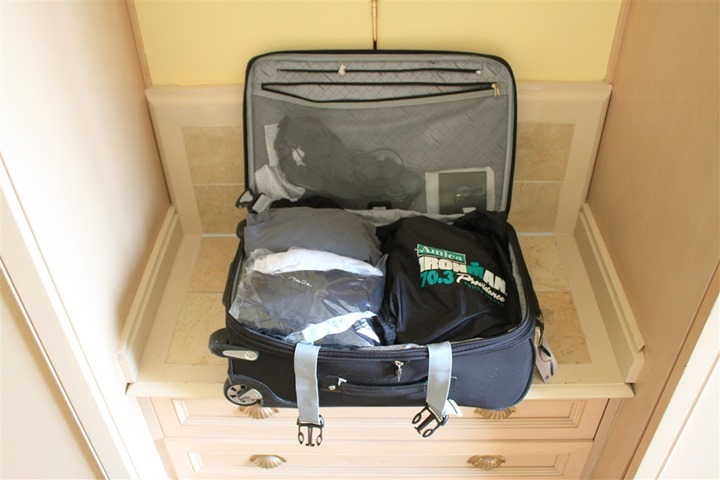
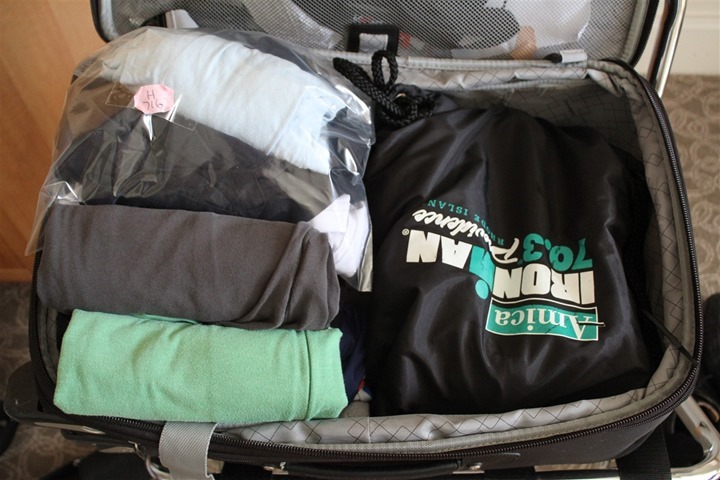
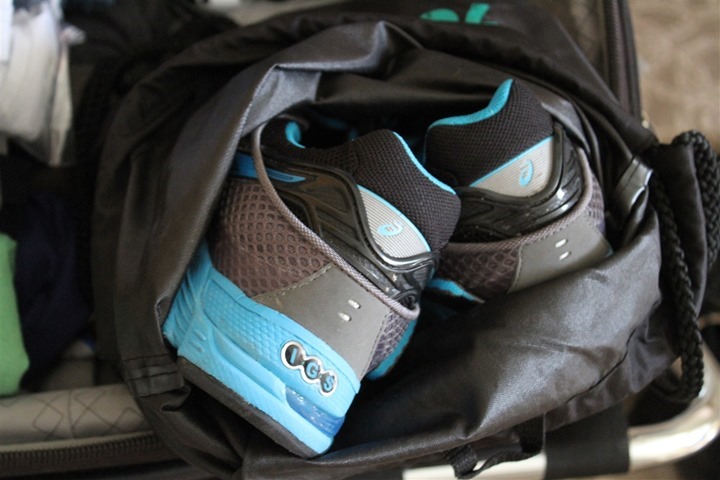
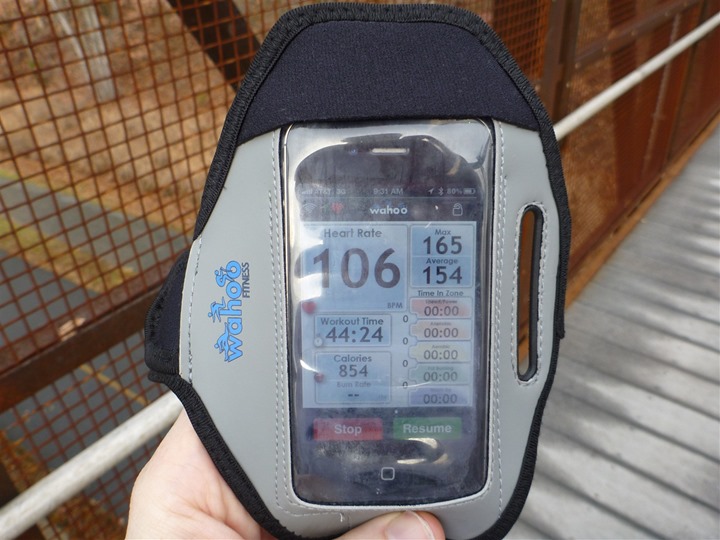

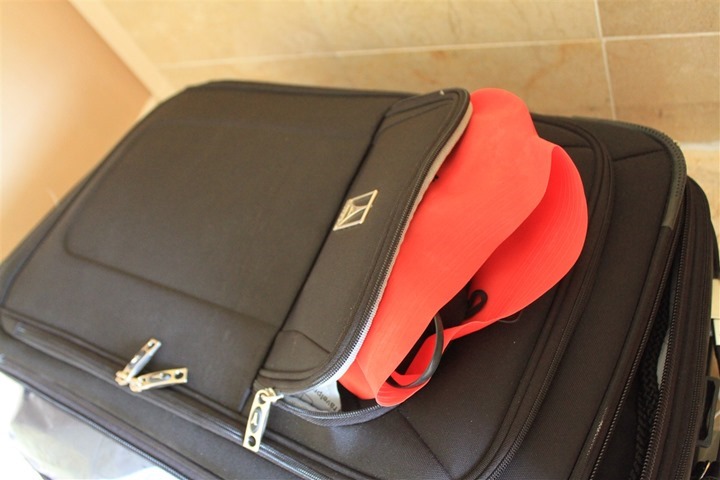
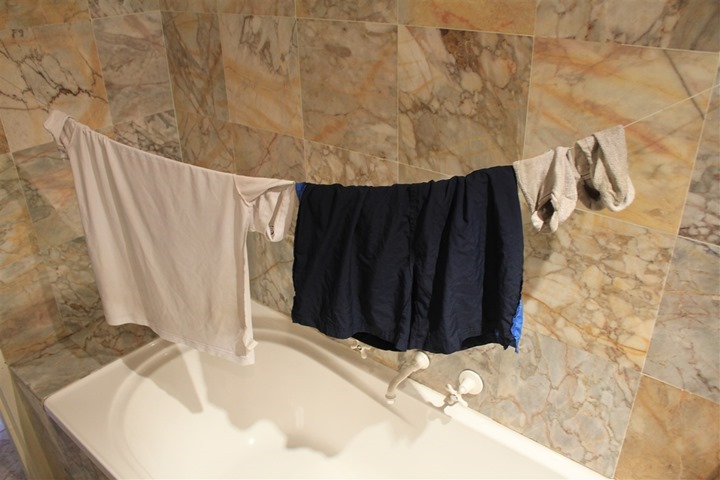

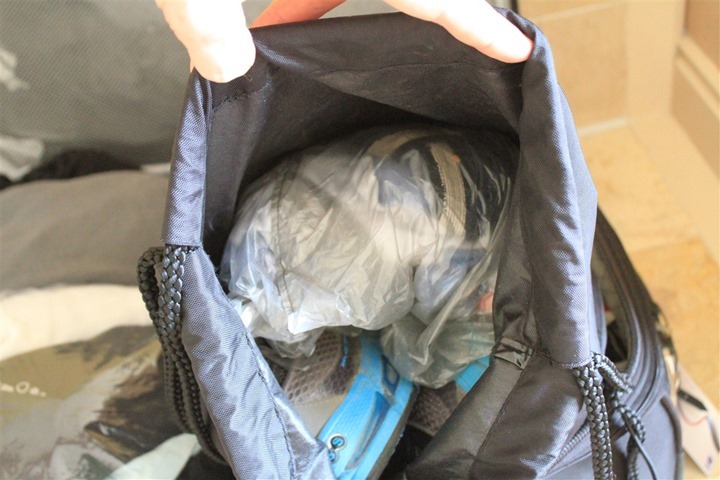
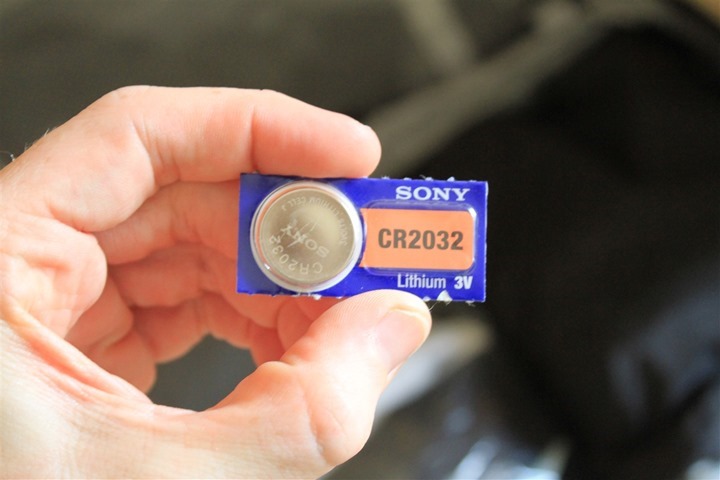

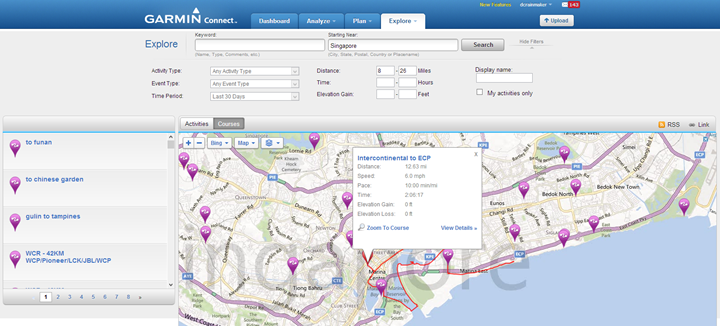

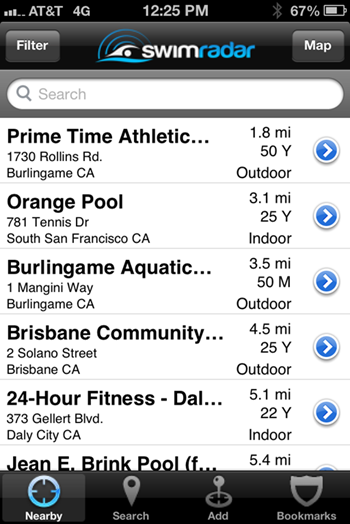
















for the Garmin Connect, i just go to Explore>Courses ?
Same question here. When I go to explore, I just get dots pointing to the start point of each course. I can’t find the feature to see the used tracks.
That’s a good point, I’ll add some clarity up above.
You actually have two relevant options under Explore: Courses and Activities.
Courses are things that people have spent time to actually outline a given route (i.e. a marathon course or regular group run route).
Activities on the other hand is simply the gigantic database of everyone else’s runs/rides (that are set to public). So that’s hundreds of thousands of activities per day being added by anyone with a Garmin device.
Courses are good in that they are more of a ‘known good’ as someone has likely spent the time to map it out. However, there are fewer of them.
Activities are good in that someone definitely ran/rode that route – however, it may not have been pretty. I tend to actually use activities more than courses, because I then look at the pace (avg) that someone did in that activity (click on it, then click “View details”) and can get a rough idea of how ‘clean’ the route is.
Note, you can always turn anybody’s ‘Activity’ into a course of your own, by simply clicking “Save as course” from the menu after clicking “View Details” on the given activity.
Hope this helps!
The heatmaps, which look brilliant to be honest, only work in the US.
The hardest distance is the 10m from the couch to the front door.
Absolutely!
Thanks, Ray!
you have answered a my question!
Hello Ray,
Thanks again for an excellent travel and excercise story.
Ray, thanks for the great tips. Can you review some of the other bike cases? IronCase, Helium, etc. I’m looking to replace my heavy hard case
I’ve looked at it, the challenge I have though is that all the other cases require big-time airline fees (especially being I live international, everything is an international fee). For me, the main attraction of the case I use is that it doesn’t get hit with most fees.
That said, I continually hear really good things about the Helium (still have the fee issues).
Hi Ray
Some great tips there. You definitely pack light.
As an airline pilot here in AU I probably challenge you for days away from home(just) and hence training challenges. As a mountain biker at least I don’t have to find a swimming hole, but carrying a bike away with you can be a major worry(damn baggage handlers!). Finding great runs and climbs supplements my ride schedule and if all else fails, the hotel gyms get a thrashing.
Thanks for sharing.
Dave
One thing you did not mention in this post (which is already very complete) is eating. What about it in the morning? Do you skip breakfast? Just curious, maybe you’ve written about it before…
Skip breakfast? That’s my favorite meal of the day! Well, except dessert.
Typically I don’t eat much before working out. The only exception being the beastly 2hr bike/run bricks where I’ll take a banana or two. But I tend to eat right after working out.
If I’m in the US, then I’ll try and hit up Starbucks for Turkey Bacon + Mocha Lite Frappacino combination (I prefer that specifically because I know the calorie count). Otherwise, if outside the US I’ll just do bagel/cream-cheese or the like.
Great article Ray.
One tip, for a 6’3″ guy w battleship-size 14 feet: Nike Free shoes fold flat in the suitcase and take up barely any room. I’m not a minimalist shoe guy, except when I travel.
Stay thirsty, my friends.
One more thing: I recently asked at a Hyatt in Cincinnati (ok, not Paris or Bejing) where to run. They gave me this little card, a room-key sized map, with several routes of different lengths, including one that took me into Kentucky. A two-state run!
Here’s the 3rd party that provided the map… Not endorsing the overall service, but the map card was a delightful consolation prize for having to spend a night in Cincinnati.
link to athleticmindedtraveler.com
That’s cool. The Hyatt in Seoul also had that as well. I might actually start staying at Hyatt hotels more just for that option. I used the Hyatt Seoul’s one and adapted it – but it gave me a great validated starting point.
Ray –
Great post as always! One related tip from a triathlete that travels a lot for work but not nearly as much as you: if its an option, join your local YMCA. Where ever you travel you’ll have access up to ten visits a year as long as you are in good standing with your home Y. This has allowed me to swim and work out whenever I go for work. Usually buy not always that guarantees a nice 25 yard pool.
Very timely post for me. Two night trip in Perth, which thus far has managed a 10km run along the river, a 50km bike (ok I flew in early so knew I’d get chance for this) plus the extra bonus of a 5km treadmill run when the consensus was “lets have half an hour to shower and meet in the lobby”. Half an hour?! That’s 5km plus shower time. I wasn’t even last to meet!
Completely echo your points on time zones. for me getting up at 4am rather than 6am means exercise pre work day (2 hour time difference for me anyway) so another run in the morning awaits I expect. I’d have done less at home.
Great post. Thanks
Excellent post. I’d also love to hear from women who work out while traveling, especially about getting ready in the morning (15 minutes from shower to car is not feasible for me on a workday, but could possibly see getting that down to 30) and, more importantly, safety issues.
For example: I was on a business trip in a not-entirely-safe area of a foreign country recently, and was elated when I found out the hotel offered guided group runs. The exact schedule didn’t work with our conference schedule, though, and the hotel staff heavily discouraged me from running by myself. At the end of the conference, I was speaking to another runner in the group (a 6’2″ man) who had been running by himself very early every morning and could not understand why I hadn’t been doing the same. I felt like I had no way to find out how safe the area actually was — any advice?
Hi Ray,
Actually aside from the air pollution, china lends itself very much for biking.
After all it was the cycling nation of the world until the cars took over.
Where will you be?
I travel every other week too, but only short trips, and several times a year intercontinental trips.
As always, love reading your blog
Ken
In Beijing and Xi’an – mostly Beijing though. Are there good (and relatively easy to get to) options for long rides in Beijing? Preferably something where a cyclist is semi-safe.
cycling do not know, for running suggest try out the Beijing Olympic forest park, not the Olympic green but the real forest park, nice area especially in morning, pre-measured and marked tracks for 3/5/10km runs
I have had no luck finding courses with GarminConnect. I go to Explore->Courses. I know there are TONS of trails, paths, and courses all over South Orange County. Many of them are ones I run (and use my Garmin 610 on), yet only a smattering shows up. It’s useless to me :(
Excellent! Here I was thinking I’m the only one who uses the “clothes hanger on the vent” trick.
I do a fair bit of travel (about half to a third of the miles you do Ray) and have found these packing cells to be fantastic to organize a suitcase, let me know next time you are headed to NZ and I’ll fix you up with some: link to kathmandu.co.nz
Thanks Thor! I’m actively looking for my next excuse to go back to NZ…trust me!
Thank you for your detailed info and answering my question too but can you also do one post for your back pack too.That is where I find everything gets crazy with all the tech stuff and security checks.
I really would like to know how you deal with this :)
To add to the post wish list…like many other sites (life hacker etc)I would be interested in a “What’s in your bag” (side bag) for local and overseas work.
Great site! Thanks
Hey Ray! That 22in case above….. Does that have your work clothes as well?? We’re do they go?? TW
Yup, I have two options – depending on how formal the meetings are. For non-formal where I’m doing slacks with dress shirts, I just roll the dress shirts/pants and re-iron, thus they are on the left.
For more formal, the suitcase comes with a suit protector thingy, which allows me to put in suit/coat/shirts/pants/etc in on top of everything you see. Works surprisingly well once you figure it out (kinda complex the first few times like a game of Tetris).
Very cool article! I always wonder how you have the time/energy to fit everything in, and how you make sure you have everything you need before travelling. You really have all of this down to a science! Thanks for making me feel bad for skipping workouts when I’m home all the time!
Great post Ray!
I travel Asia most of the time while living in HKG. I find it hard to go outside for a 90 mins run when humidity is up to 90% and the temperature doesnt drop below 30 Celcius. Do you go out and run or stay in the hotel and spend 90 mins (or longer) on the boring treadmill while watching CNN?
It’s a bit of getting adapted to it slowly. When I loved in Washington DC, many summer days could be just as bad as anywhere in Asia from a heat & humidity standpoint (dry air it was not).
Now, when I travel (for example, tomorrow) to China – I’ll probably suffer a bit on the longer runs. Which is one of the reasons my coach has shorted my run to only about 90 minutes while in Beijing, because the heat/humidity will come as a big shock compared to today’s temperature (50*F and raining).
I’ve done a few treadmill runs in really hot climates where the run quality was of significant importance – i.e. peaking during my build cycle and really needed to get a specific run in. But otherwise, I train in running mostly on HR, so I just let the pace slide and maintain the correct HR’s.
Isn’t Beijing the place you wouldn’t want to breath too much outside air?
link to stateair.net
I think you really don’t want to be running outside in Beijing. The heat/humidity is irrelevant, the problem is the pollution. Remember to bring a quality facemask, too.
link to kopf.github.io
Yup, I’ve been watching those charts and will be mostly following the state departments website for whether it’s safe to run.
Dear Ray,
thanks a lot for the interesting article.
What you didn’t mention tho, is how you keep it with sleeping…
So, for example in the schedule posted, when did you go to bed? What is the average time you sleep? How long is your sleeping time if you don’t have time constraints (or, in other words, do you sleep rather long or short)?
I’m by far not travelling as much as you, but during travels the typical thing is to arrive late – getting up early, and I always prefer to get some sleep instead of getting up even earlier to get a workout done.
Thanks for your thoughts on this!
When I go to bed varies quite a bit. At home, if I’m not immediately back from travel it’s usually 2-3AM. But on the road I try and get it closer to 12AM-1AM as long as I’m waking up after 6:30-7AM. If before then (such as 5AM), I’ll get it closer to 10:30-11PM.
Two things I will add as I travel every week for work as well by taking two flights to and from my client site:
1) The suitcase shown above is a great one. The 22″ Travelpro ‘Crew’ series is the best for the money in my opinion. The wheels are replaceable should they every faulter and Travelpro has a great warranty program should the handle or anything else fail due to general wear and tear.
2) Bring your foam roller with you and stuff clothes in the hollow portion. The shorter Trigger Point foam roller fits perfectly in the 22″ Travelpro suitcase in a horizontal position. I can stuff 2-3 pairs of running shorts and 2-3 shirts/tanks in there if I folder them end-to-end. You don’t lose much space at all in your bag since it’s hollow.
Hey Ray!
Thanks for another great post. Did i see Asics in your bag? Thought you were a die NB fan? :-)
You need to do a cupcake give-a-way..
No seriously!
Indeed, The Girl bought them for me, and I just put them on and started wearing them. No particular reason to be honest.
Great post! Boggles my mind when coworkers say they dont have time to get a workout in when traveling. I would go nuts if I didnt when traveling! I wish I traveled that much for work (probably only 50ish percent for me)..is your company hiring? haha
Great post! I only do 50-100K/year these days, but this will help reduce my excuses!
Thanks for a view into how to pack more lightly. If I could, I’d take *everything*!
Ray, fantastic post and perfectly timed as I’m flying to Paris next week for 3 nights on business (I live in the UK)!
Seeing as you’re native now, do you have any recommendations for favourite pools/run routes. I’m staying fairly centrally near the Arc De Triomphe but have never been there before.
Favorite pools in Paris? Now that’s an oxymoron. ;)
For runs, run down from the Arc to Concord (just follow the big street). At Concorde, navigate to the river without getting run over in the giant intersection. Once at the river, stay on the same side and run until the Eiffel tower, cross river, then run a big loop around the park of the Eiffel tower until you’re back at the main street. Now, staying on the south side of the river, continue back towards Concorde. When you arrive at Invalides (giant green park with a gold dome), if you want to add an extra 1.75ish miles, do a loop around it. Now, keep going upstream on river on same side. Eventually, you’ll hit Notre Dame (2 miles after leaving Invalides). Once there, loop around the island and then head back towards ‘home’. As you hit the Louvre (it’s right along the river), drop into the main park in front of it and run through it towards the Arc. You should be able to keep the Arc in sight from almost all the way at the Louvre if along the main drag.
Enjoy!
What does your typical hotel gym bike workout look like? Steady effort for a certain time? Intervals? If so, how do measure them? Usually I just do a steady effort and up the intensity whenever I feel like it. No structure. I’ve been thinking about bringing my laptop into the gym and doing HR based TrainRoad workouts. Something with long steady intervals. Thoughts?
It varies a lot, but generally not steady state. Usually I’m just mapping my bike trainer workouts onto the gym. Sometimes minor variations, but almost always the same. Often times 5m intervals, etc…
Just as an additional note, the Nike + website also does a heat map as well (you do need to create an account though). Doing a compare for a couple of areas between Garmin Connect and Nike +, sometimes one brings up a few more routes than the other although my recent travel to Wyoming, MI didn’t bring up much of anything. But a little research on the city’s website led me to a great paved bicycle/jogging path!
Very helpful post, thanks! Two follow-up questions:
– Do you have any tips for packing cold-weather gear?
– When you go to a spin class, I assume you need to bring your own clipless shoes? If so, any tips about packing them?
Here’s a bit more on what I run/use while training in cold weather: link to dcrainmaker.com
When it then comes to packing for cold weather, I tend to just go with a single pair of running tights and a single longsleeve top + longsleeve fleece + gloves. And just wash as required during the trip.
For spin class, I’m actually just using the spin bikes – not the class itself. In most cases I just use tennis shoes with them, rather than lug additional shoes with me. In almost every case you can find a traditional pedal cage somewhere in the room.
“I travel almost every week, from quick 75 minute train rides to 22 hour flights. Every week is a new country and usually a new continent.”
IT you say…. I’m beginning to think you’re a hit man.
Appreciate the post – this was one of my big curiosities I mentioned in the survey. So my one question still lingering is how on earth do you cool down from a run, shower, get dressed in 15 minutes? I live in New Orleans and consistently need 30 minutes before I’m even cooled down enough to get in the shower, let alone putting on work clothes and heading out the door – I’ll be a sweaty mess. You just naturally cool down that quickly? Or ignore the sweat factor?
All of my workouts have a 5-minute cool-down period built into the end of them. Usually, with that, I’m pretty much good to go. Perhaps I cool down quicker!
Being sweaty is definitely a bit of a pet peeve of mine, so if I’m still warm I’ll take a cold shower for a minute or two before going with luke-warm for the rest. All good then!
Well done Ray, I travel a fair bit too and always struggle to find longer run routes, my 910xt is helpful to find my way back to the hotel and I always try to head to water as that tends to have a run-able bank, here are a few of the routes I have taken trying to squeeze some exercise into work travel. I call it running tourism link to runningtourism.blogspot.co.uk or runism and like to take a few photos on the way! Lately I have been concentrating on some runs into towns from the airport which removes the need to motivate yourself to get running.
Excellent tips for tavel. I also travel quite a bit for work. Most of my trips stateside are 5-7 days and overseas are 10-15 days. It was interesting to see we have been doing many of the same techniques.
For washing out workout clothes I rinse them in the sink and hang them on hangers also. One additional step i learned from another traveler is, after ringing out the clothes, I lay out a bath towel, lay the clothes out on top, then roll it up and wring it and then let it sit for 15-30 min. then hang them. really helps them hang dry fast, espesially in the damper cllimates.
As for riding, I try to locate a local bike shop/rental prior to leaving. If the region has good riding there are usually good rentals. I have saved an older pair of shoes and pedals and take those with me. I probably average 50-60.00 for a 24 hour rental. So if I have time for a good, long ride, it is still cheaper to rent than pay to fly your bike. If I rent a bike, I usually end up hooking up with a local. Most are proud to show off thier routes.
hank you for all your reviews and how to’s. They save me lots of time and money.
Since this is an older article I’m sure you already know about this but for my travel (which tends to be extensively international) I use Strava’s global heatmap that is now available in labs.
link to labs.strava.com
Jonathon
Hi
I’m a road warrior triathlete too. On a plane typically once a week. Travel is not regular so can be 1-5 days. I’m US only so that is good. My big problem is getting my hair done in the am. Yes sometimes its a 3am wake-up, thank god for the 24 hr gyms. I can’t do it less than 30 minutes unless I want a really short do- which I don’t. I use a travel clothesline by Rick Steves. Its velcro on both ends which works most times to attach from one point to another. Its braided rubber so only a little bit of material cut in it is how its hung and the clothes get more air to dry. As far as breakfast is concerned, I try to stay at one chain and use the free breakfast, if one is offered or concierge room if the higher end of the brand. I throw a another top over the sweaty body, grab oatmeal in take-out coffee cup, fruit, etc. Then sort of eat and get ready. Again, the hair is why I have to double duty here.
Great tips! The article is very helpful. My husband travel almost every week and it is a good idea to know how to pack his clothes and shoes. Greetings